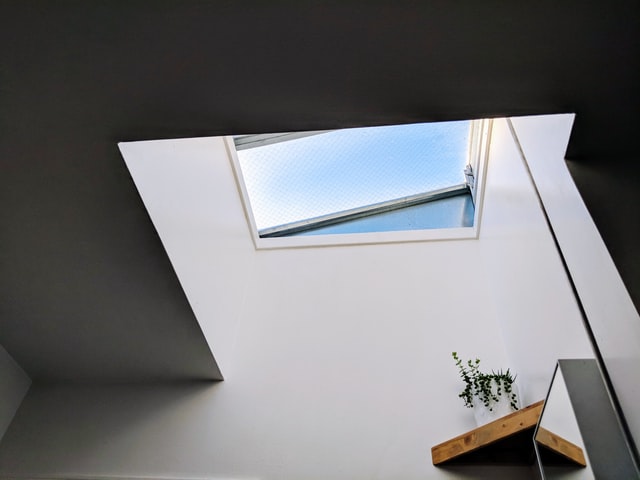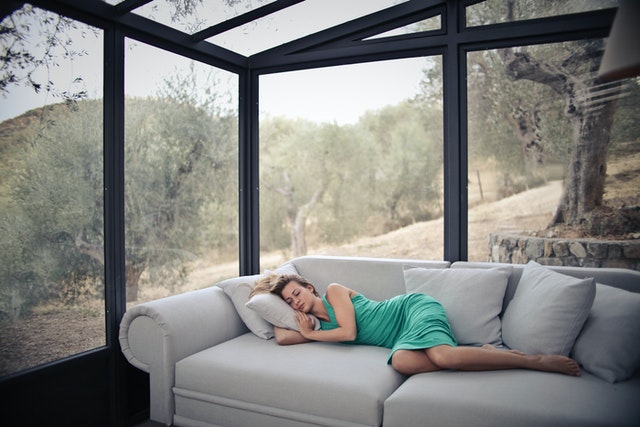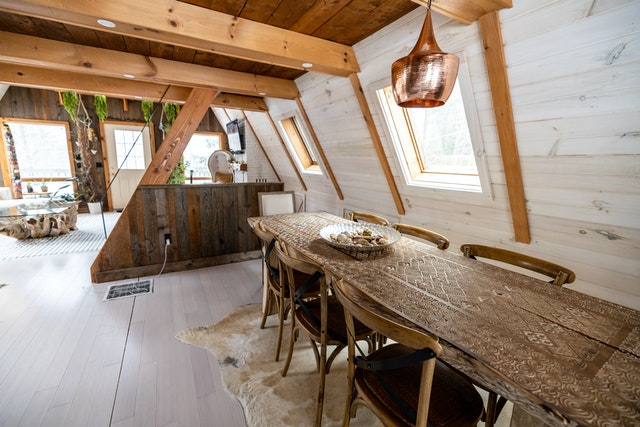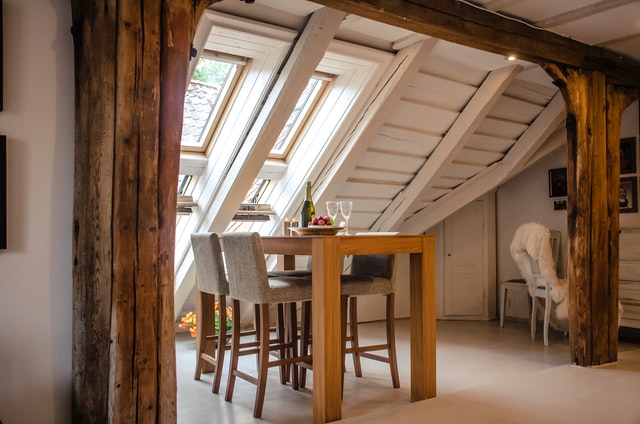Natural light is the best way to make your home feel bright, cheerful, and airy. Natural light looks incredible, and it can also positively impact your mood, give you space to grow indoor plants, and reduce your energy bill.
Skylights are a superb way to incorporate more natural light into your home without sacrificing wall space or blocking windows with furniture, wall art, and shelving. Skylights and roof windows aren’t the same thing — roof windows open and allow for ventilation, whereas skylights are purely for lighting purposes and do not open.
What are the different types of skylights?

You might think of skylights as all the same, but several different varieties are designed for specific types of spaces. It’s worth taking some time to consider each option before you purchase one type and book an installation.
Fixed skylights
Fixed skylights are probably the ones you’re the most accustomed to seeing. The traditional skylight provides natural light to your space but doesn’t open up for ventilation.
The plus side of this type of skylight is that they allow a lot of light in, and are commonly dome-shaped, which draws in more light than a flat window. Fixed skylights have a more robust seal and leak less frequently than vented skylights. These skylights are incredibly versatile in terms of which room they work best in your home. Bathrooms are an excellent spot for this, especially if you’re in the habit of doing your makeup in there — natural light is the holy grail for well-blended makeup!
One of the drawbacks of a fixed skylight is that you can’t use them to let heat out in the summer or for air circulation because they don’t open. In a temperate climate like Oregon, this might not be a priority. On the flip side, for all of the desert-dwellers out there who experience scorching summer heat, this is something you might want to consider when you’re choosing which skylight works the best for you.
Flared skylights
A flared skylight features a roof opening smaller than the one in your ceiling, so it acts like a funnel in reverse — taking a smaller amount of light and projecting it into a larger space.
Flared skylights are an excellent option if your roof space is limited, but you have larger interior ceiling space. This could be the case if you have a feature on your roof that needs to be worked around or if the design of your roof leaves only a tiny space above a larger room below.
Vented skylights
A vented skylight looks the same as a fixed skylight, but it opens to allow ventilation to the inside. The difference between a vented skylight and a roof window is the domed shape of the glass.
Tubular skylights
Tubular skylights can be a contentious topic, you’ll either find people that love them or hate them, but there isn’t a lot of middle ground. This type of skylight is just as its name sounds — instead of a square or rectangular piece of domed glass, tubular skylights are just that, tubes! About the size of a pot light, these are also commonly referred to as light tubes. Small but mighty, they adjust with the light throughout the seasons and time of day, often looking just as bright as a normal light.
Given their more concentrated shape and size, tubular skylights project their light onto a smaller space and are more suited for a place where you’d have an overhead light rather than a window.
Shaftless skylights
A shaftless skylight is a bit of a misnomer — this skylight is actually an LED light panel, not a traditional skylight.
Fixed skylights and light tubes use mirrored material to amplify outside light and reflect it into your home. While this works great, it also boosts the heat coming into your house. A shaftless skylight emits light close to the natural light spectrum without the added heat coming into your home with the light. Since these are LED-powered, these skylights use very little energy, and the bulbs are long-lasting.
What type of skylight you choose and whether you’re putting them into a new build or an existing roof will determine whether you’ll need a builder for the installation or if a handyman might be able to help you.
The benefits of skylights

The benefits of having skylights in your home are myriad. Here are the top reasons we love this type of lighting!
- Natural lighting isn’t just good for your energy bill — it’s also a significant factor in your mental health. The light spectrum of natural light has been proven in scientific studies to impact mental health issues like depression and anxiety positively. This is partly because of the effects of the light rays on your brain chemistry, but not just that. Natural light is also great for growing plants, something else associated with improved mental health.
- Natural views are a huge plus in having skylights. Your rooms will look larger because they’ll be brighter and have less shadowy space, and you’ll also get beautiful overhead views and feel like your ceilings are higher than they are.
- Resale value is always something to think about when looking at a renovation or upgrade to a new build. Will your extra investment come back to you with returns, or will you have thrown money away on something that won’t hold its value when you sell? With skylights, it’s a safe bet that you’ll reap the rewards when the time comes to sell. Bright homes with lots of natural light are a real estate agent’s dream since you don’t get many buyers that say, “I wish this room were darker.”.
- Energy efficiency is increasingly on everyone’s mind, and skylights are a great way to reduce your heating and cooling bill and your electricity bill. More natural light and ventilation mean you’ll automatically reach for the light switch and thermostat less, leading to welcome savings on your energy bill.
- Ventilation is a significant factor if looking at a vented skylight option. Most vented skylights have a manual crank that easily opens your skylight with a few twists, giving you a perfect way to cool your home in the summer months by letting the heat escape. Some newer vented skylights have electronic systems that you can control with a remote or a smart home app if you’re feeling extra fancy! Solar heat is the flip side of the summer ventilation benefits of skylights. In the winter, the reflective material that brings light into your home also carries heat, even more so than a regular window. This means that your cooling bill goes down in the summer, and your heating bill decreases in the winter — it’s a win-win.
- Natural light is beautiful and makes any home look more warm and welcoming. Think of that happy and contented feeling when your home is bathed in warm sunlight and picture having even more of that year-round.
- Certain areas can be tricky to light, like staircases and hallways. You can bring bright, natural light into those spaces with skylight and light tubes, giving you an alternative to always needing to have a light on in darker spaces.
Where’s the best location to place my skylight?

Different rooms in your home benefit for specific reasons from having the natural light provided by skylights — let’s explore.
Kitchen
Kitchens are notoriously difficult to light because any shadows create spots that are harder to use for things like chopping veggies and preparing food – you don’t want to be blocking your light with a sharp knife in your hand. The other side of the coin is that you also can’t shine an overly bright light in your eyes while you’re chopping away, so the kitchen is a great place to utilize the diffuse natural light from a skylight.
Bathroom
Most of us undertake personal grooming in our washrooms, which always benefits from natural light. Not only can you see details more clearly with diffuse natural light, but you’re also less likely to suffer the consequences of having a shadow in the wrong place when you’re shaving or doing your makeup.
Bedroom
Waking up with natural light is leaps and bounds better for you than artificial light. While this can be tough because we use curtains and blinds for privacy and to shield ourselves from streetlights and our neighbor’s porch lights, skylights offer an option that lets natural light in without sacrificing privacy or letting in outside light when you’re trying to sleep.
Attic
The attic might not seem like your first choice to put a skylight since it’s probably not where you spend your day! If your budget allows, however, adding a skylight to your attic storage space can make it easier to see when you’re in there, not to mention deterring pests and allowing UV light to ward off mold and mildew.
There’s no question that skylights are a brilliant way of providing natural light to all types of spaces. Adding skylights or light tubes isn’t just a great way to bring sunlight into your home, but it gives you the option to cut your HVAC and electricity bill while adding to the resale value of your home. All in all, skylights are tops!




